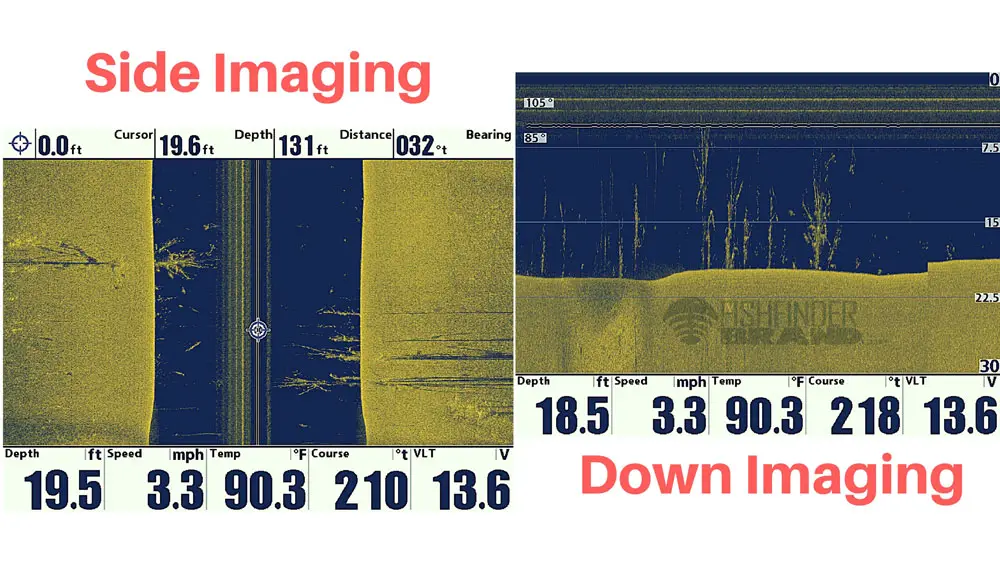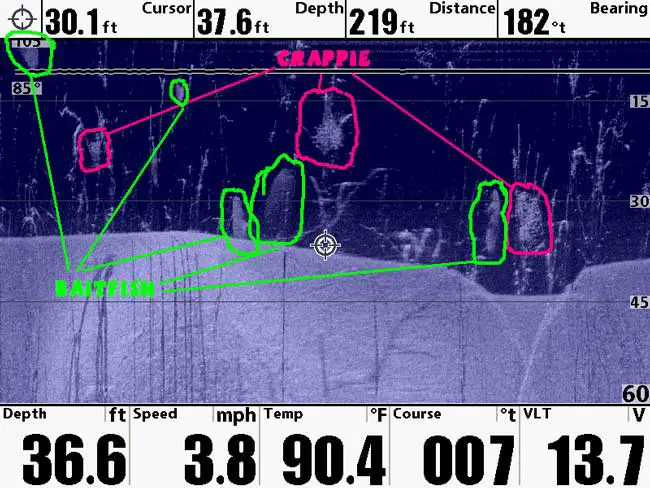Have you ever thought of comparing down imaging versus side imaging sonar? Having a fish finder with side imaging and down imaging is one thing; knowing the one to use at a given time is another.
In this article, we will examine what is better: down imaging or side imaging. We will look at the better option between down imaging and side imaging in respect to kayak.

We will examine advantages and disadvantages of down imaging and side imaging on trolling motor and for crappie.
Often times, I receive comparisons questions such as DownVü vs Down Imaging, SideVü vs Side Imaging, Sidescan vs Side Imaging, Downscan vs Down Imaging.
One of the reasons side imaging and down imaging are tough concepts to comprehend is the fact that these terms are usually used for marketing purposes; hence, the proprietary names.

For instance, a leading fish finder manufacturer, Garmin, uses the term “DownVü” as their down imaging system. On the other hand, Lowrance uses DownScan and SideScan. Alternatively, down imaging and side imaging are terms used by Humminbird.
Aside from the nomenclature, anglers often struggle to identify the direction in which their fish finders emit sonar waves.
While down imaging fish finders have a transducer directing sonar waves beneath the boat, side imaging fish finders direct beams toward the side of the boat. It should be noted that both types of imaging are innately better in certain ways over each other. Consequently, it is always vital to understand the circumstances that each is optimized for.
Down Imaging vs. Side Imaging
In this part of the article, we will squarely compare the down imaging versus the side imaging. We will explore the advantages and disadvantages of each of them.
A. Side Imaging

Advantage | Disadvantage |
|---|---|
B. Down Imaging



Advantage | Disadvantage |
|---|---|
What’s better: Side Imaging or Down Imaging?
Both fish finders are different in the way they operate and the things they are optimized to do. When determining which is best for you, you should consider the depths you will be fishing as well as the speed you will love to travel at. Additionally, you should think about the fish size and the cover you will be fishing on.
Frequently Asked Questions (FAQs)
Both fish finders are different in the way they operate and the things they are optimized to do. When determining which is best for you, you should consider the depths you will be fishing as well as the speed you will love to travel at. Additionally, you should think about the fish size and the cover you will be fishing on.
1. Down Imaging or Side Imaging on Trolling Motor?
If you love trying something different, you will like the side imaging on a trolling motor. By doing this, you can see fish while traveling at Zero mph. For better structure, you should move at 3mph to take note of the down imaging/side imaging.
Down and Side Imaging on Trolling Motor (VIDEO Tips)
The SI for structure requests that you move, but the trolling motor won’t be able to move too much to the right or the left. Nonetheless, you will see fish and obtain more information than the 2D sonar.
2. Down Imaging or Side Imaging for Kayak Fishing?

Modern technologies in kayak fishing have given anglers the edge to do more and discover much more. In kayak fishing, side imaging technology comes with greater depth finders and is more expensive than the down imaging and 2D sonar.
With side imaging, you are able to scan a larger area compared to what is achievable with down imaging. Additionally, you can easily find underwater structure and mark points off side imaging.
While these are possible with down imaging, you may have to be sitting directly over the water body to have an idea of the shape as well as the extent of the water.
3. Which fish Finder Included Side Imaging and Down Imaging?
4. Down Imaging or Side Imaging for Crappie?

With side imaging, you have real-time information and images of what is under the water both to the left and right side. Down imaging, however, are better suited for crappie as they provide you with incredible and comprehensive details of the location directly below you.
In this way, we can say that side imaging is ideal for trolling, while down imaging is ideal for vertical jiggers.
Our Vedict
In the end, you just can’t pick a sonar type over the other. Your decision has to be founded on certain cases of use. Whether you are choosing a side imaging fish finder or a down imaging fish finder, the occasion is what will determine the one to pick.
Side imaging finders are better in shallow water and cover a wider range. Down imaging is ideal for depths and is less expensive.
My name is Alex D. Allen, and I’m a professional fishfinder researcher and fishing enthusiast. You’re probably on my website in search of a fishing device that can help make your experience a lot easier and more productive; or perhaps, just trying to glean information to get a wider understanding of what fish finders are and how they can benefit you. Whatever your purpose may be, you’ve come to the right place.

Very good video taught me alot. I never really knew how to use my fish finder much.
You’re welcome. If you have any topics idea, please leave a comment to let me know. Thank you. Enjoy!